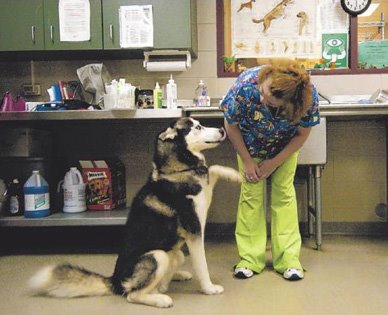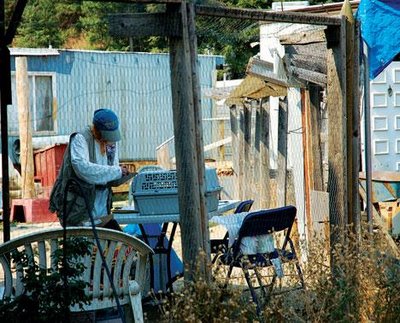Cat Killing Season Is in Full Swing All Across America as Shelters Ramp Up Their Mass Extermination Pogroms

"The greatness of a nation and its moral progress can be judged by the way its animals are treated."
-- Mohandas Gandhi
Each year tens of millions of cats and dogs are exterminated at shelters across the United States. Since most cats entering this aulirophobic world arrive during the spring, a high percentage of all feline executions occur during summer and autumn. Although America is justifiably condemned by the international community for its neglect of its poor, its failure to provide affordable health care, and its horrific war crimes against the Iraqis, Palestinians, and Lebanese, it is arguably its perennial mass slaughter of totally innocent cats and dogs that says the most about its barbaric nature.
The forlorn little kitten shown above is on death row at the Sonoma County Animal Shelter in Santa Rosa, California. If it is not adopted soon, it will be killed, dumped in the garbage, and forgotten like billions of its sisters and brothers have been in the past. More than seven-hundred cats and kittens were dumped at Sonoma County shelters during July and although kill rates have not been made public, Mickey Zeldes of the Rohnert Park Animal Shelter told The Press Democrat of Santa Rosa on August 29th that "undoubtedly euthanasia rates are going up." (See "Cats Jam Local Shelters.")
Compounding matters further is the fact that not as many cats are being adopted. "There's not the turnover. It's a one-way door," Zeldes added. This has prompted the Humane Society of Sonoma County to take the unusual step of offering would-be guardians a second cat at half-price if they will take two and this has helped somewhat to alleviate overcrowding at shelters.
Shelters charge adoption fees not only in order to make money but also allegedly to ensure that research labs, purveyors of feline and canine flesh and fur, and other abusers do not get their hands on cats and dogs. Only the first reason is valid and it has only limited merit.
High fees ($100) do not curtail evil individuals from adopting cats and dogs; money is no object for vivisectors and traffickers in animal flesh and fur. For example, when Senate Republican Majority Leader Bill Frist was studying medicine at Harvard he adopted a cat on the pretense that he was going to give it a good home but instead he took it back to his laboratory and used it as a guinea pig.
Background checks and follow-up home visits are the only ways that shelters can ensure that cats and dogs are being properly cared for in their new environments. Consequently, adoption fees should be lowered and even waived in certain circumstances if doing so will save lives.

Many poor families are willing to feed and care for either a cat or a dog but they are either unable or unwilling to pony up the adoption fee. In addition to the invaluable companionship that they offer, cats are superb mousers and dogs are capable of providing better home security than expensive alarm systems.
High adoption fees are inherently discriminatory and shelters should not be run by the bourgeoisie exclusively for the bourgeoisie. Tant pis, high adoption fees cost lives. Cats and dogs subsisting in low-income homes is far preferable to shelters full of dead animals.
There are undoubtedly some shelters that look upon homeless animals as a cash crop and accordingly prefer to see them dead than to let them go gratis or at a discount. These shelters should be closed and their proprietors jailed. Sheltering animals should be undertaken for only altruistic reasons, not financial considerations.
That which is true of adoption fees applies equally to sterilization costs. On the average it costs $135 to spay a cat and $85 to neuter one; for dogs, those figures are $205 and $153, respectively.
In Eugene, Oregon, a hodgepodge of animal welfare groups have formed a No Kill Community Coalition dedicated to establishing a low-cost sterilization clinic. They plan to offer feline alterations for $35 and canine sterilizations for $70. Poor residents will pay about one-third of the going rate with the coalition picking up the remainder. (See The Register-Guard, August 21, 2006, "No-Kill Coalition Sets Priority to Build Spay-Neuter Clinic.")
In the Bay State, the MSPCA and the Animal Rescue League of Boston admit to having exterminated twelve-thousand cats at their shelters last year. At SPCA shelters, only thirty-nine per cent of adult cats taken in last year made it out alive as compared to sixty-seven per cent of young kittens and sixty-four per cent of kittens between six and twelve-months-old. (See The Patriot Ledger, August 31, 2006, "Cat Population -- Overwhelmed: Feline Casualties Stacking Up; Shelters Euthanize as Kittens Multiply Like Rabbits.")
For shelters, killing cats and dogs is not only fun but dirt-cheap as well. A 250 milliliter bottle of sodium pentobarbital, the preferred poison of most animal houses of detention, costs only $45 and is sufficient to do away with eighty cats. That works out to fifty-five cents per cat plus an additional fifteen cents for the needle and syringe. Shelters in Massachusetts must also pay a small fee in order to use the MSPCA's crematory in Methuen.
The cats shown in the photo above on the right are two of more than fifty on death row at a shelter in Pembroke, thirty-eight kilometers from Boston. The Brockton MSPCA has thirty-two felines incarcerated and there are more than forty more at the Taunton Animal Shelter. All of this is in addition to hundreds of cats awaiting adoption at several no-kill shelters in the Boston area.

At Woodside Estates Mobile Home Park in Mansfield, Ohio, one-hundred-seven kilometers south of Cleveland, cat-hating residents have taken to shooting, poisoning with antifreeze, and running down with their vehicles some of the estimated one-hundred feral cats who have taken up residence there since the Humane Society of Richland County drastically scaled back its extermination program. Whereas it used to slaughter three-hundred felines per month, it has now stopped accepting more cats than it can find homes for and its kill-rate has nosedived to three to four cats a month. (See Mansfield's News Journal, August 15, 2006, "Mobile Home Park 'Overrun' by Stray Cats, Say Residents.")
This has led residents to falsely accuse the Humane Society, located northeast of the trailer park, of deliberately releasing cats that eventually find their way back to their doorsteps. (See photo above on the right of two cats underneath steps.) Since the organization used to foolishly allow individuals to drop off unwanted pets in boxes that it had placed outside, officials believe that people are now simply turning loose cats at the curb.
This is not an uncommon phenomenon since some irresponsible pet owners also dump unwanted cats outside bins that are intended for the collection of clothing and toys for the needy. It is as if they attach no more value to a cat's life than they do to an old pair of moth-eaten jeans. Not having the guts to commit such foul deeds on Christmas, some of these villainous pet owners hold off on abandoning their trusted companions until Boxing Day.
In central Ohio, the Licking County Animal Shelter is running a cat extermination factory. For instance, last year it killed 2,215 of its 2,437 feline residents. Feral and sick cats are slaughtered immediately upon arrival as are sick and aggressive dogs. (See The Advocate of Newark, August 29, 2006, "Residents Step Up to Care For, Control Cat Population.")
Since en masse exterminations of central Ohio's more than one million feral and stray cats is the only policy that public servants are willing to entertain, volunteer organizations such as the Cat Assistance Team of Central Ohio (CATCO) and concerned citizens such as Helen Gibbons of Helen's Family Restaurant in Newark and Dorothy Clow have begun trapping, sterilizing, and feeding homeless cats at their own expense.
Newark's Homeward Bound Humane Society, a nonprofit, no-kill organization, is operating at twice its capacity by sheltering sixty cats and twenty-four dogs. "I don't know how it couldn't be a good thing to help ferals or animals that are homeless," president Julie McCormack told The Advocate in the article cited supra. "Fortunately, it seems more and more people are helping."
In the photo below on the right a kitten whose mother was run down and killed by a motorist when she was only four-days-old is being bottle-fed by an attendant at Homeward Bound.
It is a sad commentary on the state of public affairs when practically all tax dollars go to capitalists, militarists, destroyers of the earth, and crooked politicians. Despite its humongous wealth, America has little or nothing to offer the animals, Mother Earth, or its downtrodden.

In Princeton, New Jersey, SAVE recently announced that it will no longer be admitting sickly cats and aggressive dogs. To the shelter's credit, however, it has already found a sanctuary in Minnesota that is willing to accept two of its five unadoptable dogs and fifteen cats that suffer from the Feline Immunodeficiency Virus (FIV). (See Town Topics, August 30, 2006, "No-Kill Shelter Faces Dilemma, Animals Unsuitable for Adoption.")
While this strategy will no doubt free up space so that SAVE can place more adoptable cats and dogs in new homes, it is undeniably a death sentence for sickly and feral cats as well as aggressive dogs. It is therefore incumbent upon SAVE that it not completely turn its back on all unadoptable animals, but rather that it continue to help find sanctuaries for them until some other organization steps forward to fulfill this role.
At the Humane Society of the Pikes Peak Region in Colorado Springs, Colorado, the feline extermination rate is nothing less than staggering. Through August of this year, 2,872 cats have been slaughtered but only 1,910 adopted; the reclaim rate for felines is a dismal eight per cent.
The kill-rate for dogs, although noticeably lower than that of felines, is still too high. So far this year 1,954 dogs have been executed but 3,107 have found new homes. The fact that forty per cent of all dogs entering the shelter are reclaimed by their owners suggests that either animal control is overzealous in carrying out its duties or that owners are allowing their canines to roam freely. (See The Gazette of Colorado Springs, September 3, 2006, "The Truth about Cats and Dogs.")
The shelter normally kills on the average twenty to twenty-five cats and dogs each day but because of the influx of kittens that number skyrockets to between thirty-five and thirty-eight during the summer months. The shelter takes in on the average between sixty-five and one-hundred cats and dogs per day and has one-hundred-eleven animals, primarily cats, living temporarily in foster homes.
In the photo below, Tabor Kailey of the Humane Society of Pikes Peak is shown administering a test for aggressiveness to a stray dog. How well canines and cats perform in these one-on-one interactions often determines whether they are allowed to go on living or are exterminated. If there is insufficient room at the inn, however, test performances are irrelevant and the animals are killed anyway.
All of the arguments advanced by shelters, veterinarians, and animal control officers for killing cats and dogs are bogus and dishonest. When Taunton Animal Control Officer Manny Massa told The Patriot Ledger in the article cited supra that "if they're feral, and we can't do anything with them, we have no choice but to put them down" he was lying. There are alternatives.
TNR has been proven to work in a multitude of instances all over the world. Claims by ailurophobes that feral cats damage property, kill an inordinate amount of birds, and stink up neighborhoods are lies. If for political reasons TNR is not feasible, sanctuaries such as 10th Life in Clewiston, Florida are a viable alternative.
Uncontrolled population growth, development, and pollution have however put the future of feral colonies and sanctuaries in jeopardy. If these detrimental forces are not brought under control soon, there will be neither the space nor an inhabitable environment to support either of these alternatives.

Also, not all sanctuaries are what they pretend to be. For instance, when sheriff's deputies and representatives of the Humane Society raided the Voice of the Animals' Camelot sanctuary in Blanchard, Idaho, forty-three kilometers from Sandpoint, on September 6th they uncovered a full-blown cat hoarding operation. (See photo below.)
More than four-hundred cats were crammed into dilapidated trailers that were coated with excrement from stem to stern. So far, officials have exterminated more than half of the felines allegedly for health reasons but an unwillingness to foot the bill for their medical treatment is most likely the real reason for their elimination. (See Bonner County Daily Bee, September 13, 2006, "Half of Camelot's Animals Euthanized.")
Despite the abhorrent behavior of officials in Blanchard, disease is not a valid excuse for killing cats since even those with FIV can live normal lives. Injured felines should receive medical care not death sentences and elderly cats should be allowed to complete their brief sojourns on this earth.
The same arguments apply equally to aged, sickly, and injured dogs. Although vicious canines may not be suitable for adoption, they certainly do not deserve the gallows either. Their aggression is not their fault; it is rather the product of their breeding and mistreatment by humans. Some of these animals respond to therapy and for those that do not there are sanctuaries.
More importantly, the tests that shelter workers have concocted in order to uncover wildness in cats and aggression in dogs are subterfuges designed to provide a convenient cover so that they can safely play God. Almost any cat or dog incarcerated at a shelter will behave in a frightened and unfriendly manner because they instinctively know that they have lost not only their homes and liberty but that their continued existence is also in jeopardy. Removed from the hellish, disease-ridden environment that characterizes all shelters, most cats and dogs do not exhibit violent behavior.
Only an act of Congress or a constitutional amendment will ever put an end to pet genocide. It is disgraceful that this is not the number one priority of all animal rights groups. Since these organizations are unwilling to act, it is up to animal lovers to take their case to the streets and to demand that the political establishment recognize the moral imperative and outlaw pet genocide once and for all time.
Since national action is not on the horizon, the fight must therefore be concentrated at the local level where the number one priority must be the closing of all shelters and the firing of all animal control officers. They are the problem, not the solution. As long as they are allowed to make money off of trafficking in cats and dogs the exterminations will never end. (See Cat Defender posts of November 23, 2005 and May 11, 2006 entitled, respectively, "Texas Newspaper Defends Pet Genocide by Publishing Graphic Photographs of Shelter Workers Exterminating a Dog," and "Mass Murderers at SPCA Are Operating an Auschwitz for Cats and Dogs in Lakeland, Florida.")

So-called no-kill shelters are another fraud. Most of these facilities have rather limited capacities which means that they turn away far more cats and dogs than they accept; consequently, they leave the killing to the public shelters. Moreover, their proscription against killing does not extend to sickly and aged animals or to feral cats and aggressive dogs.
Shelters should be replaced by spacious adoption agencies, sanctuaries, and foster homes. In order to make this a reality, there must be a drastic increase in public funding for animal care and welfare.
Innovative adoption strategies are also desperately needed. Many libraries already have feline mascots and other public institutions as well as commercial establishments should be encouraged to adopt cats and dogs. Laws prohibiting pets from apartments buildings and old folks' homes should be scrapped.
Finding homes, sanctuaries, and rural environments for homeless cats and dogs is sans doute a daunting challenge but Nathan Winograd, a well-known former shelter director in San Francisco, believes that it is doable. In fact, he is quoted in The Register-Guard article cited supra as declaring that a shelter running at peak efficiency can find homes for almost all stray and abandoned animals as well as feral cats.
Photos: Jeff Kan Lee of The Press Democrat (kitten at Santa Rosa shelter), Marc Vasconcellos of The Patriot Ledger (cats at Pembroke shelter), Jason Molyet of the News Journal (cats under steps), Morgan Wonorski of The Advocate (kitten with bottle), Brienne Boortz of The Gazette (dog), and Keith Kinnaird of the Bonner County Daily Bee (Voice of the Animals' Camelot sanctuary).

<< Home